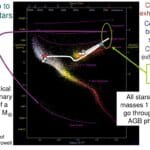Imagine our Sun, five billion years from now, swollen to a size that could engulf the Earth, pulsating rhythmically, and shedding its outer layers into space. This dramatic transformation marks the Asymptotic Giant Branch (AGB) phase, a critical stage in the evolution of stars like our Sun. These stellar giants play a vital role in the cosmic ecosystem, acting as factories for heavy elements and seeding the interstellar medium with the building blocks of future worlds. Join us as we explore the fascinating life and death of AGB stars.
Understanding the AGB Phase
Asymptotic Giant Branch (AGB) stars represent a late stage in the evolution of low-to-intermediate mass stars (roughly 0.5 to 8 times the mass of our Sun). They are cool, luminous giants, readily identifiable on the Hertzsprung-Russell (H-R) diagram. This phase follows the main sequence and red giant phases, and precedes the post-AGB phase, culminating in the formation of a planetary nebula. [https://www.lolaapp.com/]. These stars are not merely fading embers; they are dynamic and complex, playing a crucial role in galactic chemical evolution.
The Inner Workings of an AGB Star
The internal structure of an AGB star is a marvel of astrophysics. Unlike our Sun, which fuses hydrogen in its core, AGB stars have exhausted their core hydrogen supply, leaving behind an inert core of carbon and oxygen. Surrounding this core are two concentric shells where fusion continues: an inner shell fusing helium into carbon, and an outer shell fusing hydrogen into helium. This “double shell burning” process is the engine that powers these stellar giants, but it is far from stable.
The helium-burning shell is particularly prone to instabilities. It periodically experiences “thermal pulses,” sudden bursts of energy production that cause the star to expand and increase in luminosity. These pulses also trigger “dredge-up” events, where material processed in the interior, rich in newly synthesized elements like carbon, nitrogen, and oxygen, is brought to the surface, altering the star’s atmospheric composition. This process, along with the ongoing s-process nucleosynthesis (slow neutron capture), contributes significantly to the enrichment of the interstellar medium with elements heavier than iron.
Pulsations and Mass Loss: A Star’s Farewell
The thermal pulses within AGB stars drive powerful stellar pulsations, causing the star to expand and contract rhythmically over periods of hundreds to thousands of days. These pulsations, combined with the intense radiation pressure from the star, generate powerful stellar winds that expel vast amounts of the star’s outer layers into space. This ejected material, rich in the elements forged within the star, forms an expanding circumstellar envelope, a cosmic cocoon of gas and dust. This process of mass loss can be so dramatic that AGB stars can shed a significant portion of their total mass during this phase. This expelled material eventually forms a planetary nebula [https://www.lolaapp.com/], a breathtakingly beautiful structure visible across the cosmos.
The Sun’s Future as an AGB Star
In approximately 5 billion years, our Sun will embark on its own AGB journey. As its core hydrogen depletes, it will expand into a red giant, eventually transitioning into the AGB phase. During this time, it is likely to engulf Mercury and Venus, and possibly even Earth. The Sun’s outer layers will pulsate, driven by thermal pulses, and intense stellar winds will carry away much of its mass into space. This ejected material, enriched with elements like carbon, nitrogen, and oxygen created within the Sun, will become the building blocks for future stars and planetary systems. While the exact fate of Earth remains a subject of ongoing research, the Sun’s transformation into an AGB star will undoubtedly be a dramatic event in the history of our solar system.
The Uncertainties of Stellar Evolution
While we have a good general understanding of AGB evolution, many questions remain. The precise mechanisms driving the thermal pulses and the efficiency of the s-process are still being investigated. The role of magnetic fields in shaping the outflowing winds and the interaction of AGB stars with binary companions are also areas of active research. Studying AGB stars is like piecing together a complex puzzle, where each new observation and theoretical model brings us closer to a complete understanding of these fascinating objects.
AGB Stars: Cosmic Significance
AGB stars are not merely individual objects undergoing their final act; they play a crucial role in the larger cosmic drama. Their production of heavy elements through s-process nucleosynthesis is essential for the chemical evolution of galaxies. The elements they create and expel enrich the interstellar medium, providing the raw materials for the next generation of stars and planets. In a very real sense, the carbon in our bodies, the oxygen we breathe, and the silicon in our computers were likely forged in the hearts of AGB stars billions of years ago. These stellar giants, in their final act, contribute to the ongoing cycle of cosmic creation and destruction, enriching the universe with the very elements that make life possible.
What Does AGB Mean in Stars?
The term “AGB” is shorthand for Asymptotic Giant Branch, a specific region on the Hertzsprung-Russell (H-R) diagram. This diagram is a fundamental tool in astronomy, plotting stars based on their luminosity and temperature. The AGB region represents a group of cool, luminous stars in a late stage of their evolution. These stars, as we’ve explored, are characterized by double-shell burning, thermal pulses, dredge-up events, and significant mass loss. They are crucial contributors to the production of heavy elements and the enrichment of the interstellar medium. Understanding the AGB phase is essential for comprehending the life cycle of stars like our Sun and the chemical evolution of galaxies.
To know more about the real meaning behind the word fattom, you can click on the fattom meaning link provided.
- Senior at What Age: Benefits & Eligibility Guide - March 29, 2025
- Unlocking Senior Benefits: How Old is a Senior? Your Complete Guide - March 29, 2025
- Master Russian Politeness:A Guide to Saying Please - March 29, 2025
















